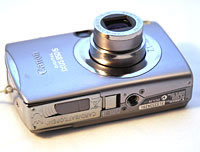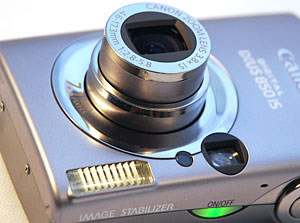 Hovering near the top of Canon’s popular Ixus range is the IXUS 850 IS, a 7.1 megapixel ultra-compact sporting a 3.8x optical zoom lens and a 2.5in monitor.
Hovering near the top of Canon’s popular Ixus range is the IXUS 850 IS, a 7.1 megapixel ultra-compact sporting a 3.8x optical zoom lens and a 2.5in monitor.
The lens offers a usefully wide 28-105 mm zoom range – great for group shots and landscapes – with Canon’s Optical Image Stabilisation system helping keep images sharp in low light.
With its rounded edges and compact dimensions (89.5 x 58.0 x 25.1mm) the Ixus is designed to be a carry-everywhere pocket snap shooter. It looks pretty to the eye too, with a stylish two-tone, semi-matt metallic colour scheme contrasting against the chrome details.
The all metal case looks pretty tough, with the smoothed and recessed controls ensuring that the camera doesn’t get snagged in your pockets.
 All that metal means that it’s not the lightest camera around, and with its lardy 150g weight (without battery) you’re unlikely to forget it’s in your pocket.
All that metal means that it’s not the lightest camera around, and with its lardy 150g weight (without battery) you’re unlikely to forget it’s in your pocket.
The controls
The camera’s basic controls are pretty easy to get to grips with. The illuminated power on/off switch lies recessed on the top plate, which means it’s very hard to turn on accidentally, but, conversely, those with larger fingers may find it quite hard to operate.
Next to the power switch is the shutter control surrounded by a little lever for zooming in/out. Again, folk with sausage sized fingers (or simply wearing gloves) may have trouble getting to grips with it.
 On the back, a circular shooting mode switch – orientated vertically – has a handy lip that conveniently doubles up as a thumb rest, making for a fairly sure camera grip.
On the back, a circular shooting mode switch – orientated vertically – has a handy lip that conveniently doubles up as a thumb rest, making for a fairly sure camera grip.
A large and crisp 2.5″ 207k colour LCD screen dominates the back of the camera, with all the camera controls positioned to the right.
Most of the camera’s functionality is accessed through a circular 4-way control with a central OK/Function Set button, while two buttons below are used to set display preferences and call up the menu interface, with a third button accessing Print/Share controls.